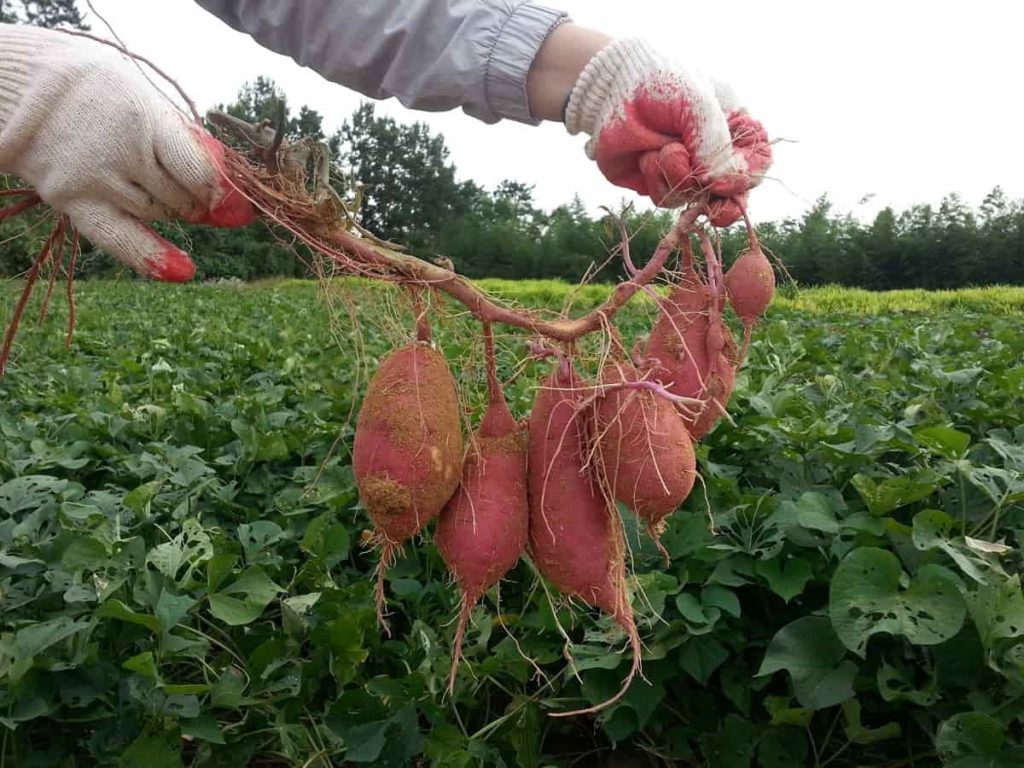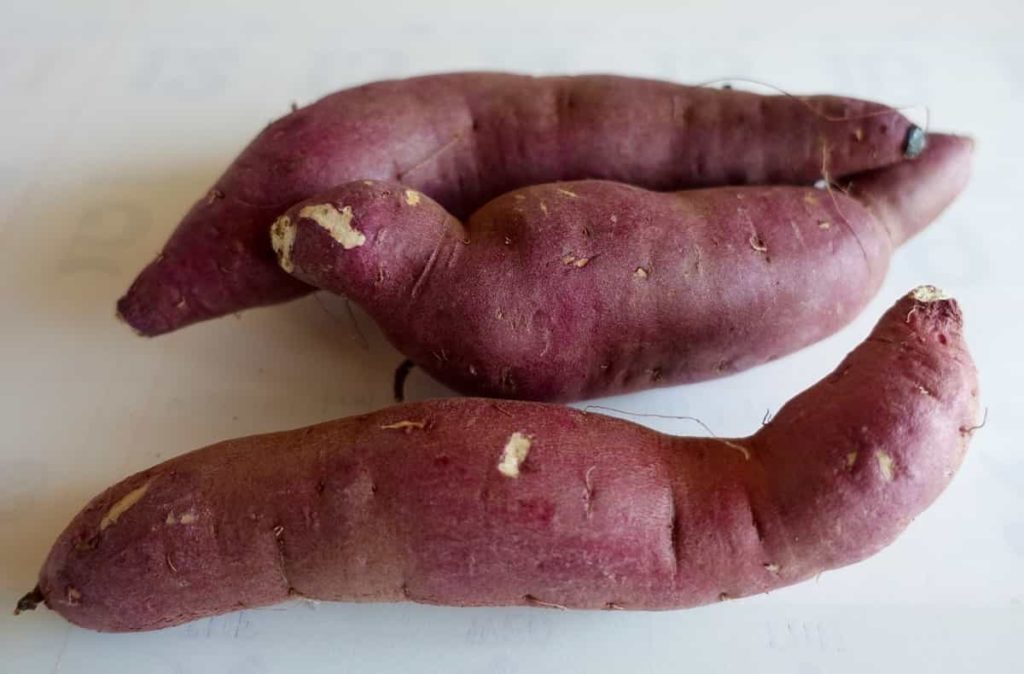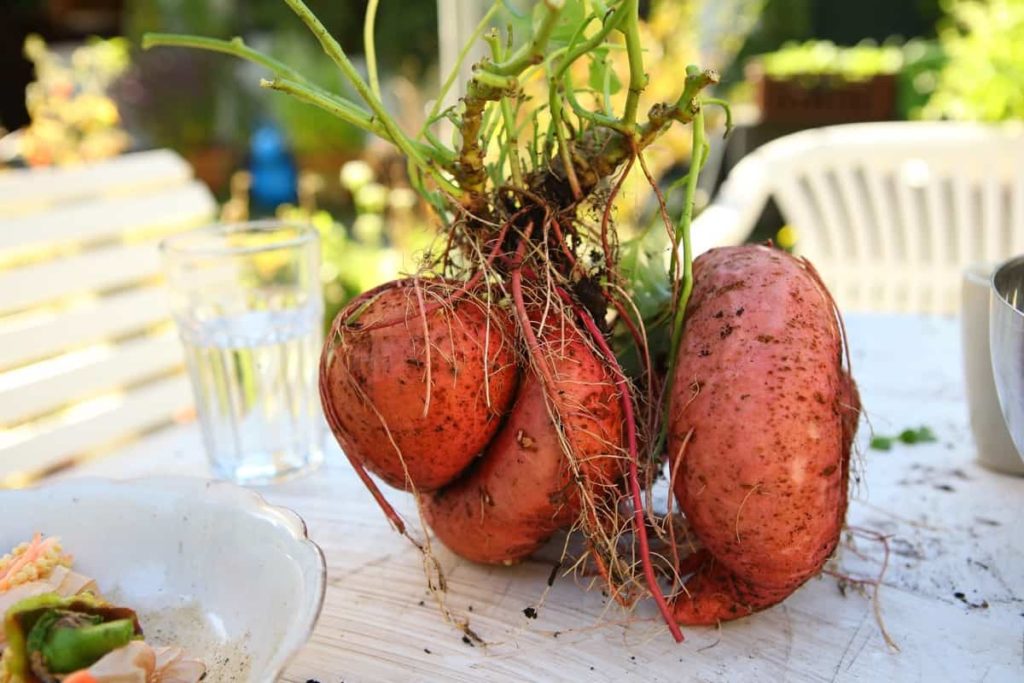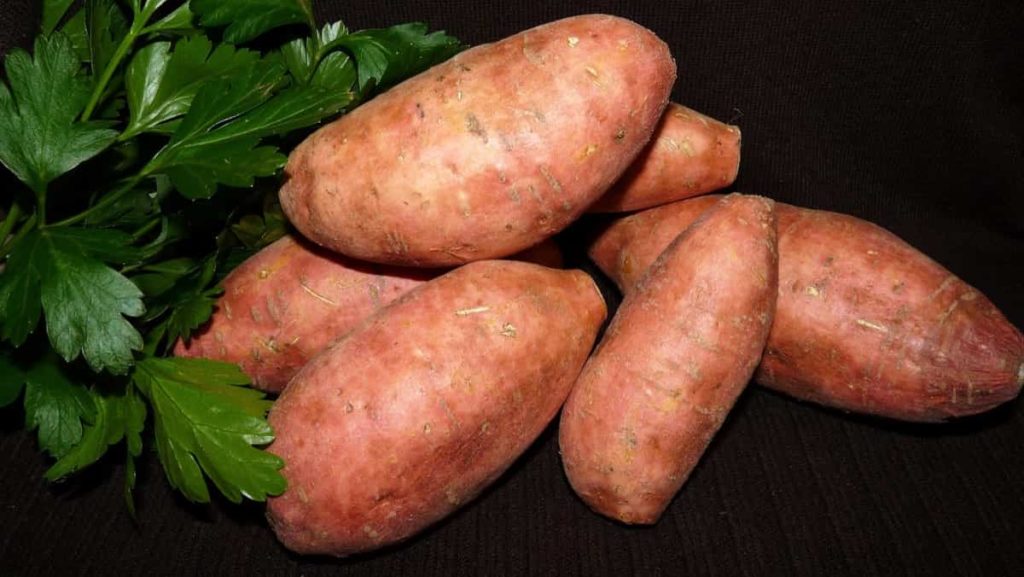Sweet Potato should be planted in a place receiving full sun with enough space for the vines to grow. For excellent growth, the soil should be drained thoroughly and has a good balance of three macronutrients i.e., nitrogen, potassium, and phosphorus. Soil samples should be analyzed before adding any modification of lime-like fertilizer or soil to determine soil pH and composition. Let’s check out the best fertilizer for Sweet Potato.

Sweet Potato grows best with soil pH between 5.0 and 6.0. If the soil is heavy with soil, adding rich organic substances like compost, leaves, and grass clippings will help to loosen the soil and improve drainage. Finally, less nitrogen fertilizer can be added before planting. Potassium plays an important role in the production of Sweet Potatoes. But the potassium source you use also affects your crop yield and quality.
Although Sweet Potatoes do not require a lot of nitrogen, there is still a balancing process with proper application. The higher application will result in higher leaf growth, but lack of roots and very little nitrogen will also minimize crop yields. Lack of phosphorus can result in stunted growth, further reduction in production. Each of these three essential plant nutrients will have different needs between different varieties of Sweet Potatoes.
Boron is more important in Sweet Potatoes than most other crops, as it prevents blistering disorders. It is difficult to visually see the lack of boron, but symptoms can include chlorosis, thickening of young leaves, puckered leaves, and root damage. Until the Sweet Potato is stored properly and for a while and deep spots are lifted on the crop, the blasting will not appear.
Most common problems with poor fertilization
- If bringing fertilizer in proper proportion during cultivation brings many benefits, you can imagine that not doing so creates some problems.
- Insufficient intake of potassium will result in longer and worse Sweet Potatoes. If it has been fertilized over nitrogen, it will be possible to feel that the plant will have a great growth of its leaves, but not its roots. So, the production will not be good. On the contrary, if nitrogen content is low, the results will be the same. In this case, the leaves will not grow excessively. The intake of insufficient phosphorus can cause a few tonnes of the crop, which will be particularly noticeable in intensive crops.
In case you miss this: Sweet Potato Gardening – How To Start, Tips, and Ideas

Best fertilizer for Sweet Potato
Compost manure for Sweet Potato
Compost
Compost provides most of the nutrients needed by Sweet Potatoes. When choosing compost, choose a good-age, fully composted, or make sure your homemade fertilizer is completely rotten and has no non-composting substance. Avoid high nitrogen compost, such as compost made from animal manures, because too much nitrogen in the soil results in small tubers. Plant-based compost or compost made from low nitrogen sources, such as leaf molds, are better suited to Sweet Potatoes.
Cow manure
Ideally, Sweet Potato likes to grow in well-drained, light-structured soil but can be modified by adding 6 to 8 inches of organic matter like compost, rotten cow manure, or peat to heavy soil.
Chicken manure
Fresh chicken manure can be very hot to grow Sweet Potato, as it is high in nitrogen and can burn your plants. Farmers are not recommended to use a high amount of chicken manure in Sweet Potato production.
Natural fertilizers for Sweet Potato
Once the vines start growing mulch the pathways or around the plant with an organic mulch pattern such as straw or untreated grass clippings. Apply a layer of organic mulch, such as pine bark or grass clippings, which will help maintain soil moisture and temperature, as well as reduce weeds.
In case you miss this: Sweet Potato Growing Tips, Tricks, Ideas, and Secrets

Homemade liquid fertilizers for Sweet Potato
Epsom salt
Add some Epsom salt to the soil while planting to help promote magnesium which will help build walls of Sweet Potato. For a more direct approach, 1 tablespoon can be mixed with a gallon of water and applied directly as a foliar spray on the leaves.
Seaweed
Seaweed contains many useful plant nutrients, including nitrogen, potassium, phosphates, and magnesium. Feeding monthly with seaweed fertilizer, and water sparingly.
Organic fertilizers for Sweet Potato
Bone meal, kelp meal, and green sand are organic choices for Sweet Potatoes that are lower in nitrogen than potassium and phosphorus. Don’t over-compost. Sweet Potato is not a heavy feeder, so if your soil is less than ideal it should be applied occasionally.
Bone meal
Bone meal provides calcium for your Sweet Potato plants. Calcium improves the growth of roots, encourages strong roots, and helps prevent blossom end rot. Bone meal can balance other soil modifications.
Kelp meal
kelp meal delivers macronutrients (nitrogen, phosphorus, and potassium) and micronutrients to all plants. It can increase soil structure, increase root growth, and is good for overall plant health, as it gives them more nutrients.
Organic nitrogen sources in the fertilizer are provided by blood meal and fish meal, while phosphorus is provided from rock phosphates and bone meal. Nutrients can also be supplied with feather meal, molasses, or potash. Use a mixture of about 4 pounds of organic fertilizer for every 100 feet row of Sweet Potato before planting, working the fertilizer in the top 8 inches of soil.
In case you miss this: Growing Sweet Potatoes in the Backyard

Commercial fertilizers for Sweet Potato
NPK ratio
Nitrogen encourages a plant to produce more leaves. Phosphorates and potassium encourage more root growth. Since potatoes are a root vegetable that grows below the soil level, phosphorates and potassium are more beneficial for Sweet Potato growth. The fertilizer ratio of 5-10-10 works well for Sweet Potatoes.
Sweet potato fertilizer schedule
Commercial fertilizers
You can start fertilizing Sweet Potatoes about 2 weeks after transplanting them to your garden. Then, they can be fertilized every 4 to 6 weeks during the growing season. Generally, 3 doses of fertilizer are sufficient in the growing season. The second application of fertilizer can be added as a side-dressing two to four weeks after planting Sweet Potato.
Low nitrogen, high potash fertilizer is recommended for side-dressing, which is kept 3 inches deep and 4 inches alongside young vines. Granular fertilizer is fine while plants are still small. But if it comes in contact with plants, it can burn them. As plants grow and start to expand, it is very easy to apply a fertilizer that you can mix with water. In addition, you can use water-soluble fertilizer during your regular water routine, which is less time-consuming, especially if you have a hose-end sprayer.
Organic fertilizers
Working compost in the soil before planting Sweet Potato provides initial nutrients for healthy growth. Well-draining, in rich garden soil, an early fertilizer application can be everything necessary for the whole season of growing Sweet Potatoes. Spread a 2 to 4-inch layer of compost or leaf mold over the soil and then spread it up to 8 to 12 inches of soil. In poor soils with little natural organic matter, such as in sandy or rocky soils, they use up to 6-inch layers of compost.
In case you miss this: Growing Sweet Potato in Terrace, Pots, Bags from Tubers

Compost does not just provide nutrients; it also improves soil capacity to keep moisture and aerate plant roots. A side dressing of compost or leaf mold in the middle of summer, about six to eight weeks after Sweet Potato plants began growing, provides a new infusion of nutrients to fuel growth for the remainder of the season. Dig shallow, 2-inch furrows 6 inches away from plants, make sure that no damage to any developing tubers, and spread the compost into the furrow.
Alternatively, spread an inch of compost on the soil around the plants, but do not place the fertilizer directly against the plant trunks. Nutrients for the remainder of the growing season will be rich in soil from compost. If you use a mixture of organic fertilizer instead of compost, apply about 2 pounds per 100 feet row, or apply it using the furrow method.
How to fertilize Sweet Potato in pots
Fill your container with high-quality potting soil until the soil reaches an inch below the rim. Press the soil firmly as the tuber needs to breathe to grow larger. If your potting soil does not contain fertilizer, mix one tablespoon of 5-10-10 fertilizer with the same amount of potting soil. Mix a potting medium for Sweet Potato using three parts pine bark, one part peat moss, and one part sand.
Alternatively, you can use a combination of equal parts of peat and perlite or equal parts of peat, perlite, and vermiculite. Once your soil is mixed, place the seeds on top of the soil and cover them with dry dirt or a thin sand layer. Apply good quality organic fertilizer 30 days after planting. And adding a good amount of organic matter while applying slips ensures strong growth.
In case you miss this: Guide to Growing Potatoes in Texas: At Home, In Backyard, Containers, In Winter and Summer

Frequently asked questions about fertilizers for Sweet Potato (FAQ)
Why are my Sweet Potatoes long and skinny?
Too much nitrogen in the soil causes long, skinny roots. When planting next season, don’t improve the soil in your Sweet Potato patch with anything that might add nitrogen (such as compost), and don’t fertilize.
Why are my Sweet Potato leaves turning yellow?
Magnesium deficiency will also show as yellow leaves as magnesium is used by the plant to make chlorophyll.
Is Miracle-Gro good for Sweet Potatoes?
Sweet potatoes can usually protect themselves, although they benefit from weekly deep water during severe droughts. Or, only feed with water-solving plant food, such as Miracle-Gro plant nutrition every week.
- Best Liquid Fertilizer for Flowering Plants
- How to Set Up an Efficient Watering System for Home Garden
- How to Mulch Tulip Bulbs: Expert Tips Best Tulip Blooms
- Common Problems with Potted Figs and How to Solve Them
- How to Prevent Flower Drops in Pomegranate Trees: Effective Tips
- How to Boost Ridge Gourd Flowering and Yield: A Beginner’s Guide
- Effective Pollination Techniques for Maximizing Gourds Yield
- Composting Techniques for Manure in Home Gardens
- A Step-by-Step Guide on Propagation Techniques for Jasmine Plants
- How Do I Make My Garden Less Cluttered: A Beginners Guide
- Growing Red Currants at Home for Beginners
- Gardening Techniques in Planting Vegetables
- Where to Place Indoor Plants in Your Home
- How to Grow Tomatoes Organically at Home: A Comprehensive Guide
- Organic Gardening on a Budget: Low-Cost Methods and Materials
- Gongura Seed Germination and Planting Methods
- Cabbage Seed Germination and Selection
- Broccoli Seed Germination and Selection
- Asparagus Seed Germination and Variety Selection
- Seasonal Flower Gardening: Best Practices for Spring, Summer, Fall, and Winter
- How to Grow Hibiscus from Flower
- Plantation Ideas for Home Decoration: A Beginners Guide
- Flower Garden Designs and Layouts for Beginners
- Planting and Spacing Techniques in Papaya: A Beginner’s Guide
- Growing Gold: Essential Techniques for Planting Pineapples
- How to Make Kalanchoe Plant Bushy: Home Remedies and Solutions
- 11 Reasons Why Your Gardenia is Not Blooming: Home Remedies and Solutions
- Eco Elegance: The Guide to Designing a Drought-Tolerant Landscape
- Gardening on a Slope: Strategies for Hillside Landscaping
- Nourish and Flourish: Top Organic Mulches for Thriving House Plants
- Everything You Want to Know about Indian Mogra Flower: Discover Uses and Growing
- Green Thumb Success: Expert Tips for Cultivating Greenhouse Pumpkins All Year Round
- Maximize Growth & Flavor: The Ultimate Guide to Companion Planting in Herb Gardens
- How to Control Rhododendron Problems Naturally: Home Remedies and Organic Ways to Fix Them
- Natural Magic: The Remarkable Benefits of Cinnamon for Plants
- Best Steps to Revive Dying Tulip with Natural and Organic Treatment